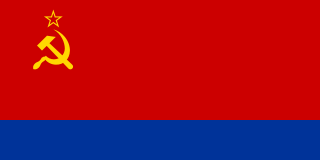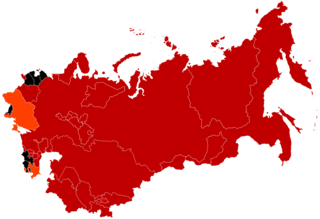
The Republics of the Union of Soviet Socialist Republics or the Union Republics were national-based administrative units of the Union of Soviet Socialist Republics (USSR). The Soviet Union was formed in 1922 by a treaty between the Soviet republics of Byelorussia, Russian SFSR (RSFSR), Transcaucasian Federation, and Ukraine, by which they became its constituent republics of the Union of Soviet Socialist Republics.

The State Flag of the Union of Soviet Socialist Republics, or simply the Soviet flag, was a red banner with two communist symbols displayed in the canton: a gold hammer and sickle topped off by a red five-point star bordered in gold. The flag's design and symbolism are derived from several sources, but emerged during the Russian Revolution. It has also come to serve as the standard symbol representing communism as a whole, recognized as such in international circles, even after the dissolution of the Soviet Union in 1991.

The Byelorussian Soviet Socialist Republic, also known as Byelorussia, Belarusian SSR, Soviet Belarus, or simply Belarus, was a republic of the Soviet Union (USSR). It existed between 1920 and 1991 as one of fifteen constituent republics of the USSR, with its own legislation from 1990 to 1991. The republic was ruled by the Communist Party of Byelorussia and was also referred to as Soviet Byelorussia or Soviet Belarus by a number of historians. Other names for Byelorussia included White Russia or White Russian Soviet Socialist Republic and Belorussian Soviet Socialist Republic.

The Karelo-Finnish Soviet Socialist Republic, also called Soviet Karelia or simply known as Karelia, was a republic of the Soviet Union. It existed from 1940 until it was made part of the Russian SFSR in 1956 as the Karelian Autonomous Soviet Socialist Republic. The latter became the Republic of Karelia, a federal subject of Russia, on 13 November 1991.

The Ukrainian Soviet Socialist Republic, abbreviated as the Ukrainian SSR, UkSSR, and also known as Soviet Ukraine or just Ukraine, was one of the constituent republics of the Soviet Union from 1922 until 1991. Under the Soviet one-party model, the Ukrainian SSR was governed by the Communist Party of the Soviet Union through its republican branch, the Communist Party of Ukraine.

The Transcaucasian Socialist Federative Soviet Republic, also known as the Transcaucasian Soviet Federative Socialist Republic, or simply Transcaucasia, was a republic of the Soviet Union that existed from 1922 to 1936.

The Georgian Soviet Socialist Republic, also known as Soviet Georgia, the Georgian SSR, or simply Georgia, was one of the republics of the Soviet Union from its second occupation in 1921 to its independence in 1991. Coterminous with the present-day republic of Georgia, it was based on the traditional territory of Georgia, which had existed as a series of independent states in the Caucasus prior to the first occupation of annexation in the course of the 19th century. The Georgian SSR was formed in 1921 and subsequently incorporated in the Soviet Union in 1922. Until 1936 it was a part of the Transcaucasian Socialist Federative Soviet Republic, which existed as a union republic within the USSR. From November 18, 1989, the Georgian SSR declared its sovereignty over Soviet laws. The republic was renamed the Republic of Georgia on November 14, 1990, and subsequently became independent before the dissolution of the Soviet Union on April 9, 1991, whereupon each former SSR became a sovereign state.

The Azerbaijan Soviet Socialist Republic, also referred to as the Azerbaijani Soviet Socialist Republic, Azerbaijan SSR, Azerbaijani SSR, AzSSR, Soviet Azerbaijan or simply Azerbaijan, was one of the constituent republics of the Soviet Union between 1922 and 1991. Created on 28 April 1920 when the Russian Soviet Federative Socialist Republic brought pro-Soviet figures to power in the region, the first two years of the Azerbaijani SSR were as an independent country until incorporation into the Transcausasian SFSR, along with the Armenian SSR and the Georgian SSR.

The Volga German Autonomous Soviet Socialist Republic, abbreviated as the Volga German ASSR, was an autonomous republic of the Russian SFSR. Its capital city was Engels located on the Volga River. As a result of the German invasion of the Soviet Union in 1941, the Volga German ASSR was abolished and Volga Germans were exiled.

An index of articles related to the former nation known as the Soviet Union. It covers the Soviet revolutionary period until the dissolution of the Soviet Union. This list includes topics, events, persons and other items of national significance within the Soviet Union. It does not include places within the Soviet Union, unless the place is associated with an event of national significance. This index also does not contain items related to Soviet Military History.

The Presidium of the Supreme Soviet was the standing body of the highest body of state authority in the Union of Soviet Socialist Republics (USSR). The presidium was elected by joint session of both houses of the Supreme Soviet to act on its behalf while the Supreme Soviet was not in session. By the 1936 and 1977 Soviet Constitution, the Presidium of the Supreme Soviet served as the collective head of state of the USSR. In all its activities, the Presidium was accountable to the Supreme Soviet of the USSR.

During the existence of the Soviet Union, different governments existed within the Crimean Peninsula. From 1921 to 1936, the government in the Crimea was known as the Crimean Autonomous Socialist Soviet Republic and was an Autonomous Soviet Socialist Republic within the Russian Soviet Federative Socialist Republic (SFSR); from 1936 to 1945, the name was slightly altered to the Crimean Autonomous Soviet Socialist Republic.

National delimitation in the Union of Soviet Socialist Republics was the process of specifying well-defined national territorial units from the ethnic diversity of the Union of Soviet Socialist Republics (USSR) and its subregions.

The transfer of the Crimean oblast in the Soviet Union in 1954 was an administrative action of the Presidium of the Supreme Soviet that transferred the government of Crimea from the Russian SFSR to the Ukrainian SSR.

The Act of Declaration of Independence of Ukraine was adopted by the Supreme Soviet of the Ukrainian SSR on 24 August 1991.

The New Union Treaty was a draft treaty that would have replaced the 1922 Treaty on the Creation of the USSR to salvage and reform the Soviet Union. A ceremony of the Russian SFSR signing the treaty was scheduled for 20 August 1991, but was prevented by the August Coup a day earlier. The preparation of this treaty was known as the Novo-Ogaryovo process, named after Novo-Ogaryovo, a governmental estate where the work on the document was carried out and where Soviet President and CPSU General Secretary Mikhail Gorbachev talked with leaders of Union republics.

The Russian Soviet Federative Socialist Republic, previously known as the Russian Soviet Republic and the Russian Socialist Federative Soviet Republic, as well as being unofficially referred to as Soviet Russia, the Russian Federation, or simply Russia, was an independent federal socialist state from 1917 to 1922, and afterwards the largest and most populous constituent republic of the Soviet Union (USSR) from 1922 to 1991, until becoming a sovereign part of the Soviet Union with priority of Russian laws over Union-level legislation in 1990 and 1991, the last two years of the existence of the USSR. The Russian SFSR was composed of sixteen smaller constituent units of autonomous republics, five autonomous oblasts, ten autonomous okrugs, six krais and forty oblasts. Russians formed the largest ethnic group. The capital of the Russian SFSR and the USSR as a whole was Moscow and the other major urban centers included Leningrad, Stalingrad, Novosibirsk, Sverdlovsk, Gorky and Kuybyshev. It was the first socialist state in the world.

The Central Executive Committeeof the USSR, which may be abbreviated as the CEC, was the supreme governing body of the USSR in between sessions of the All-Union Congress of Soviets from 1922 to 1938. The Central Executive Committee elected the Presidium, which, like its parent body, was delegated governing authority when the other was not in session. The chairman of the Presidium, served as the ceremonial head of state of the USSR. The Central Executive Committee also elected the Council of People's Commissars which was its executive and administrative organ. The Central Executive Committee of the USSR was established in 1922 by the First All-Union Congress of Soviets, and was replaced by the Presidium of the Supreme Soviet in 1938.

The Declaration and Treaty on the Formation of the Union of Soviet Socialist Republics officially created the Union of Soviet Socialist Republics (USSR), commonly known as the Soviet Union. It de jure legalised a political union of several Soviet republics that had existed since 1919 and created a new federal government whose key functions were centralised in Moscow. Its legislative branch consisted of the Congress of Soviets of the Soviet Union and the Central Executive Committee of the Soviet Union (TsIK), while the Council of People's Commissars composed the executive.

The Soviet of Nationalities was the upper chamber of the Supreme Soviet of the Union of Soviet Socialist Republics, elected on the basis of universal, equal and direct suffrage in accordance with the principles of Soviet democracy. Until democratization in the late-1980s, however, only a single candidate nominated by the Communist Party of the Soviet Union was permitted to stand for election in each constituency. It was briefly succeeded by the Soviet of the Republics from October to December of 1991. As opposed to the Soviet of the Union, the Soviet of Nationalities was composed of the nationalities of the Soviet Union, which in turn followed administrative division rather than being a representation of ethnic groups.


















